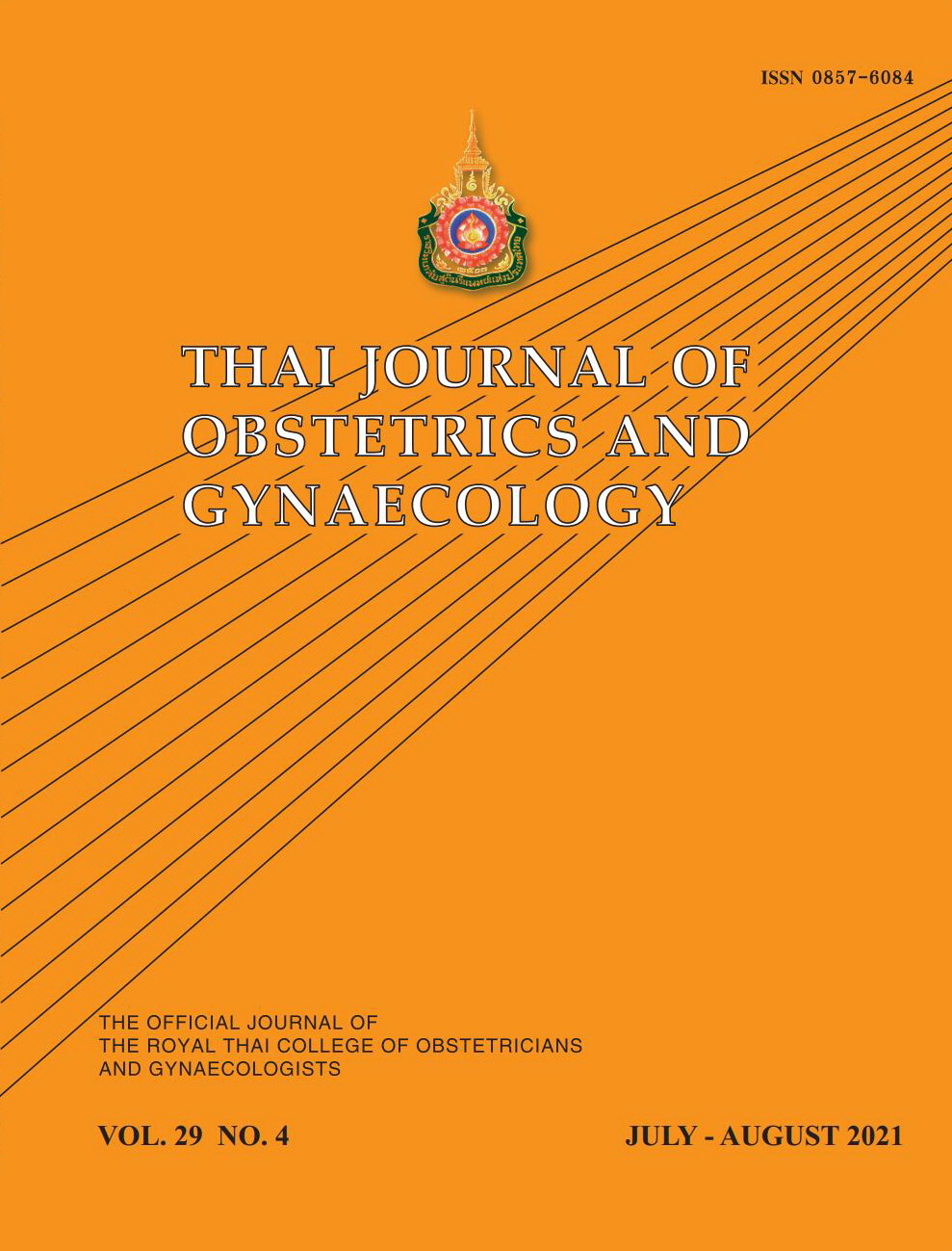Cesarean Section Rate Based on The Robson 10-group Classification at Rajavithi Hospital from 2015-2018
Main Article Content
Abstract
Objectives: To analyze cesarean section (CS) rates based on the Robson 10-group classification system (TGCS) and to examine the trends of cesarean section rates at Rajavithi Hospital (RH) between 2015 and 2018.
Materials and Methods: This cross-sectional study included all deliveries in RH between 1st January, 2015 and 31st December, 2018. The TGCS was used to categorize cesarean deliveries and all data collected.
Results: A total of 19,840 deliveries were analyzed. The annual CS rates were 35.5% (1710/4813), 36.6% (1809/4949), 35.2% (1836/5223) and 34.8% (1689/4855) in 2015, 2016, 2017 and 2018, respectively. The trend of the CS rates in each group and that of relative and absolute contributions were similar within the study period (p = 0.290). Group 1, 3 and 10 accounted for almost 70% of the study population and multiparous women with previous CS in (30.8%, 32.6%, 31.9% and 31.9%; p = 0.718), followed by group 2 (17.5%, 18%, 18.9% and 17.9%; p = 0.506) and group 1 (16.1%, 16.8%, 14.4% and 15.2%; p = 0.211), respectively.
Conclusion: The overall CS rate during the four-year period 2015-2018 varied between 34.8% and 36.6%, and the highest relative and absolute contribution to the overall CS rate at.
Article Details
References
Lumbiganon P, Laopaiboon M, Gulmezoglu AM, Souza JP, Taneepanichskul S, Ruyan P, et al. Method of delivery and pregnancy outcomes in Asia: the WHO global survey on maternal and perinatal health 2007-08. Lancet 2010;375:490-9.
Tansupasiri A, Kovavisarach E, Saenhorm P. Ceasarean Section Rate at Rajavithi Hospital from 1996-2000. Bull Dept Med Serv 2002; 27:433-8
Wachiratarapadorn N, Kovavisarach E. Trend in mode of delivery in Rajavithi Hospital: a ten-year analysis (2002-2011). J Med Assoc Thai 2013;96:768-72.
World Health Organization. Appropriate technology for birth. Lancet 1985;2:436-7.
Betran AP, Torloni MR, Zhang J, Ye J, Mikolajczyk R, Deneux-Tharaux C, et al. What is the optimal rate of caesarean section at population level? A systematic review of ecologic studies. Reprod Health 2015;12:57.
Souza JP, Gulmezoglu A, Lumbiganon P, Laopaiboon M, Carroli G, Fawole B, et al. Caesarean section without medical indications is associated with an increased risk of adverse short-term maternal outcomes: the 2004-2008 WHO Global Survey on Maternal and Perinatal Health. BMC Med 2010;8:71.
World Health Organization. Robson classification: Implementation manual. In. Geneva: World Health Organization; 2017.
Kankoon N, Lumbiganon P, Kietpeerakool C, Sangkomkamhang U, Betran AP, Robson M. Cesarean rates and severe maternal and neonatal outcomes according to the Robson 10-Group
Classification System in Khon Kaen Province, Thailand. Int J Gynaecol Obstet 2018;140:191-7.
Anekpornwattana S, Yangnoi J, Jareemit N, Boriboonhirunsarn D. Cesarean Section Rate in Siriraj Hospital According to the Robson Classification. Thai J Obstet Gynaecol 2020;28:6-15.
Triunfo S, Ferrazzani S, Lanzone A, Scambia G. Identification of obstetric targets for reducing cesarean section rate using the Robson Ten Group Classification in a tertiary level hospital. Eur J Obstet Gynecol Reprod Biol 2015;189:91-5.
Tanaka K, Mahomed K. The Ten-Group Robson Classification: A Single Centre Approach Identifying Strategies to Optimise Caesarean Section Rates. Obstetrics and Gynecology Int 2017:ID5648938.
Ferreira EC, Pacagnella RC, Costa ML, Cecatti JG. The Robson ten-group classification system for appraising deliveries at a tertiary referral hospital in Brazil. Int J Gynaecol Obstet 2015;129:236-9.
Zhang Y, Gu N, Wang Z, Zheng M, Hu Y, Dai Y. Use of the 10-Group Classification System to analyze how the population control policy change in China has affected cesarean delivery. Int J Gynaecol Obstet 2017;138:158-63.
Souza JP, Betran AP, Dumont A, de Mucio B, Gibbs Pickens CM, Deneux-Tharaux C, et al. A global reference for caesarean section rates (C-Model): a multicountry cross-sectional study. BJOG 2016;123:427-36.
Souza JP, Gulmezoglu AM, Vogel J, Carroli G, Lumbiganon P, Qureshi Z, et al. Moving beyond essential interventions for reduction of maternal mortality (the WHO Multicountry Survey on Maternal and Newborn Health): a cross-sectional study. Lancet 2013;381:1747-55.
Martel M-J, MacKinnon CJ. No. 155-Guidelines for Vaginal Birth After Previous Caesarean Birth. J Obstet Gynaecol Can 2018;40:e195-e207.


